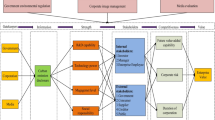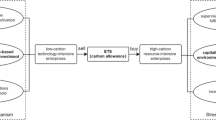Abstract
In the context of global carbon peak and carbon neutrality, the issue of how to effectively encourage enterprises to reduce their carbon emissions has drawn the attention of governments and scholars. This paper uses the difference-in-differences method and joint data (2003–2012) from Chinese industrial firm pollution database and Chinese industrial firm database to evaluate the impacts of environmental information disclosure on enterprises’ carbon emissions. We find that environmental information disclosure has a significant effect on enterprises’ carbon emission reduction. Moderating effect analysis finds that environmental regulations and punishment strengthen the role of environmental information disclosure in reducing carbon emissions, however, the moderating role of environmental punishment is limited. In addition, mechanism analysis show that environmental information disclosure can reduce carbon emissions by improving their energy structures and encouraging polluting enterprises to withdraw from the market.


Similar content being viewed by others
Data availability
The data that support the findings of this study are available from the corresponding author upon reasonable request.
Notes
The 113 pilot cities in the PITI report are detailed in Appendix Table 14.
This paper calculates standard coal using coal, fuel oil, and gas. The formula of standard coal is as follows: \(\mathrm{energy}=\mathrm{mtx}*0.7143+\mathrm{rlyx}*1.4286+\mathrm{rqx}*1.2143\). “Mtx,” “rlyx,” and “rqx” refer to “coal,” “fuel oil,” and “gas,” respectively, and the coefficients in the formula refer to the standard coal coefficients of the relevant energy. The carbon emission formula is as follows:\(\mathrm{CO}2=\mathrm{smt}*1.9003+\mathrm{sry}*3.1705+\mathrm{srq}*2.1622\). The correlation coefficients in the formula refer to the coefficients of carbon emission of coal, fuel oil, and gas, respectively.
References
Ahmad N, Li HZ, Tian XL (2019) Increased firm profitability under a nationwide environmental information disclosure program? Evidence from China. J Clean Prod 230:1176–1187
Beck AC, Campbell D, Shrives PJ (2010) Content analysis in environmental reporting research: enrichment and rehearsal of the method in a British-German context. Br Account Rev 42(3):207–222
Bu C, Zhang K, Shi D, Wang S (2022) Does environmental information disclosure improve energy efficiency? Energy Policy 164:112919
Cai X, Zhu B, Zhang H, Li L, Xie M (2020) Can direct environmental regulation promote green technology innovation in heavily polluting industries? Evidence from Chinese listed companies. Sci Total Environ 746:140810
Chang Y, Du X, Zeng Q (2021) Does environmental information disclosure mitigate corporate risk? Evidence from China. J Contemp Account Econ 17(1):100239
Doshi AR, Dowell GW, Toffel MW (2013) How firms respond to mandatory information disclosure. Strateg Manag J 34(10):1209–1231
Du K, Cheng Y, Yao X (2021) Environmental regulation, green technology innovation, and industrial structure upgrading: the road to the green transformation of Chinese cities. Energy Econ 98:105247
Du M, Chai S, Wei W, Wang S, Li Z (2022) Will environmental information disclosure affect bank credit decisions and corporate debt financing costs? Evidence from China’s heavily polluting industries. Environ Sci Pollut Res 29(31):47661–47672
Fonseka M, Rajapakse T, Tian GL (2019) The effects of environmental information disclosure and energy types on the cost of equity: evidence from the energy industry in China. Abacus 55(2):362–410
Gray R, Javad M, Power DM, Sinclair CD (2001) Social and environmental disclosure and corporate characteristics: a research note and extension. J Bus Financ Acc 28(3–4):327–356
Hu ZY, Li Y (2020) Assessment of pollution abatement effect of environmental information disclosure. Stat Res 37(4):59–74 (in Chinese)
Iwata H (2014) Disclosure of environmental information and investments of firms. MPRA Paper No. 54784
Ji Z, Yu X, Yang J (2020) Environmental information disclosure in capital raising. Aust Econ Pap 59(3):183–214
Kim EH, Lyon TP (2011) Strategic environmental disclosure: evidence from the DOE’s voluntary greenhouse gas registry. J Environ Econ Manag 61(3):311–326
Li G, He Q, Shao S, Cao J (2018) Environmental non-governmental organizations and urban environmental governance: evidence from China. J Environ Manag 206:1296–1307
Li G, Xue Q, Qin J (2022) Environmental information disclosure and green technology innovation: empirical evidence from China. Technol Forecast Soc Chang 176:121453
Li SH, Fang ZW (2021) Environmental information disclosure and markups of China’s export firms: an analysis on influence mechanism and resource allocation effect. J Int Trade 11:90–105 (in Chinese)
Lin Y, Huang R, Yao X (2021) Air pollution and environmental information disclosure: an empirical study based on heavy polluting industry. J Clean Prod 278:124313
Liu X, Anbumozhi V (2009) Determinant factors of corporate environmental information disclosure: an empirical study of Chinese listed companies. J Clean Prod 17(6):593–600
Liu Z, Deng Z, He G, Wang H, Zhang X, Lin J, ..., Liang X (2022) Challenges and opportunities for carbon neutrality in China. Nat Rev Earth Environ 3(2):141–155
Lu J, Li H (2020) The impact of government environmental information disclosure on enterprise location choices: heterogeneity and threshold effect test. J Clean Prod 277:124055
Luo Y, Xiong G, Mardani A (2022) Environmental information disclosure and corporate innovation: the “Inverted U-shaped” regulating effect of media attention. J Bus Res 146:453–463
Meng J, Zhang Z (2022) Corporate environmental information disclosure and investor response: evidence from China’s capital market. Energy Econ 108:105886
Meng X, Zeng S, Xie X, Zou H (2019) Beyond symbolic and substantive: strategic disclosure of corporate environmental information in China. Bus Strateg Environ 28(2):403–417
Ouyang X, Li Q, Du K (2020) How does environmental regulation promote technological innovations in the industrial sector? Evidence from Chinese provincial panel data. Energy Policy 139:111310
Ren S, Wei W, Sun H, Xu Q, Hu Y, Chen X (2020) Can mandatory environmental information disclosure achieve a win-win for a firm’s environmental and economic performance? J Clean Prod 250:119530
Scorse J, Schlenker W (2000) Does being a “Top 10” worst polluter affect facility environmental releases? Evidence from the US toxic release inventory. Atlantic Monthly
Shi BB, Ma C, Kang R (2019) Environmental information disclosure and optimization of foreign direct investment structure. China Ind Econ 4:98–116 (in Chinese)
Shi D, Bu C, Xue H (2021) Deterrence effects of disclosure: the impact of environmental information disclosure on emission reduction of firms. Energy Econ 104:105680
Tanaka S (2015) Environmental regulations on air pollution in China and their impact on infant mortality. J Health Econ 42:90–103
Tian XL, Guo QG, Han C, Ahmad N (2016) Different extent of environmental information disclosure across Chinese cities: contributing factors and correlation with local pollution. Glob Environ Chang 39:244–257
Tu Z, Hu T, Shen R (2019) Evaluating public participation impact on environmental protection and ecological efficiency in China: evidence from PITI disclosure. China Econ Rev 55:111–123
Wang S, Wang H, Wang J, Yang F (2020) Does environmental information disclosure contribute to improve firm financial performance? An examination of the underlying mechanism. Sci Total Environ 714:136855
Wang Y, Delgado MS, Khanna N, Bogan VL (2019) Good news for environmental self-regulation? Finding the right link. J Environ Econ Manag 94:217–235
Wen ZL, Hou JT, Zhang L (2005) Comparison and application of moderating and mediating effects. Acta Psychol Sin 2:268–274 (in Chinese)
Wei P, Mao X, Chen X (2020) Institutional investors’ attention to environmental information, trading strategies, and market impacts: evidence from China. Bus Strateg Environ 29(2):566–591
Wiseman J (1982) An evaluation of environmental disclosures made in corporate annual reports. Acc Organ Soc 7(1):53–63
Yao S, Hong Y, Lin CM (2019) Environmental information disclosure and financial constraint. Asia Pac J Financ Stud 48(5):666–689
Yao S, Yang J (2017) Geographical distance and environmental information disclosure: the perspective of public pressure transmission efficiency. Asia Pac J Financ Stud 46(3):445–462
Zhang H, Xu T, Feng C (2022) Does public participation promote environmental efficiency? Evidence from a quasi-natural experiment of environmental information disclosure in China. Energy Econ 108:105871
Zhang T, Xie L (2020) The protected polluters: empirical evidence from the national environmental information disclosure program in China. J Clean Prod 258:120343
Zhou L, Tang L (2021) Environmental regulation and the growth of the total-factor carbon productivity of China’s industries: evidence from the implementation of action plan of air pollution prevention and control. J Environ Manag 296:113078
Acknowledgements
This research is supported by the Collaborative Innovation Centter for Emissions Trading system Co-constructed by the Province and Ministry(Grant No. 23CICETS-ZD002), the Humanity and Social Science Youth Foundation of Ministry of Education of China (Grant No. 21YJC790043), the Major Project of Philosophical and Social Science Research in Hubei Universities (Grant No. 22ZD016), the Fundamental Research Funds for the Central Universities (Zhongnan University of Economics and Law: 2722023DK064) and the Fundamental Research Funds for Major project of Hunan Social Science Foundation (21ZDAJ006) .
Author information
Authors and Affiliations
Contributions
Shi He: Supervision, Writing-Reviewing and Editing
Lulu Xu: Writing original draft preparation
Daqian Shi: Methodology, Software
Corresponding author
Ethics declarations
Ethical approval
We follow the corresponding ethical standards, and then this article does not involve human or animal research.
Consent to participate
All the authors participate in the paper in full and agree to submit.
Consent to publish
All authors approved the final manuscript and the submission to this journal.
Conflict of interest
None.
Additional information
Responsible Editor: V.V.S.S. Sarma
Publisher's note
Springer Nature remains neutral with regard to jurisdictional claims in published maps and institutional affiliations.
Appendix
Appendix
The source of data: the joint data (2003–2012) from Chinese industrial firm pollution database and Chinese industrial firm database.
Table 14
Rights and permissions
Springer Nature or its licensor (e.g. a society or other partner) holds exclusive rights to this article under a publishing agreement with the author(s) or other rightsholder(s); author self-archiving of the accepted manuscript version of this article is solely governed by the terms of such publishing agreement and applicable law.
About this article
Cite this article
He, S., Xu, L. & Shi, D. How does environmental information disclosure affect carbon emissions? Evidence from China. Environ Sci Pollut Res 30, 93998–94014 (2023). https://doi.org/10.1007/s11356-023-28883-1
Received:
Accepted:
Published:
Issue Date:
DOI: https://doi.org/10.1007/s11356-023-28883-1
Keywords
- Carbon emissions
- Environmental information disclosure
- Environmental regulation
- Moderating effect
- Mechanism analysis




